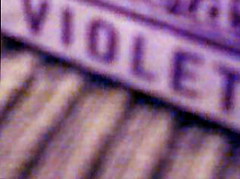Last night my roommate and I saw the Merce Cunningham Dance Company perform at the Ahmanson. For the first half of the evening, they performed a dance called Fabrications that Merce choreographed in 1987. The second half was a piece called Split Sides that he recently developed (2003). It was performed to music by Radiohead and Icelandic musicians Sigur Ros. Both pieces were fascinating, but they also made me realize how little I know about watching and writing about modern dance, or any dance really. I don't really feel like I know where to start in describing these pieces at all. I watch very little dance, actually, although one of my good friends at school is a dance critic and I've taken several classes that involve discussing and analyzing dance. I always say that I should watch more dance, that it would be good for me intellectually to be familiar with a wider range of culture and dance is in many ways very much like theater. And yet, I rarely do attend dance performances or analyze dance in any way. I probably wouldn't have gone to the Cunningham either, except that I could convince my roommate to go with me. You see, Cunningham is gay and his partner was musician John Cage for something like 50 years before Cage's death in 1992. My roommate studies John Cage, so even though neither of the pieces performed had music by Cage, we both felt like it was something we should see. And I'm very much glad we did. The dances were beautiful and fascinating and intellectually stimulating.
The first piece, Fabrications, I won't spend much time describing. It was interesting and quite compelling. In the post-show discussion, Cunningham informed us that he created it by choreographing 64 different movement sequences and then rolling a die to determine the order in which they would be performed. In recalling it, the things that I remember most were the costumes; the men wore solid colored pants and dress shirts, mostly in black and white though one man was in bright blue. The women wore very simple 1940s-style dresses but with leggings under them. The movement sequence that I liked best was one in which a single woman danced with all the men, but she led them in some very masculine movements, taking up space as one of the men. It was a great contrast to images of dance in which the women are passed around and maniuplated by the men. The whole piece was quite striking visually, but its approach to gender was what I found most interesting.
The second piece, Split Sides, was the fascinating and exciting one. It began with audience members onstage rolling dice to determine which of two music pieces (Sigur Ros or Radiohead), costumes (black and white or brightly colored), music pieces (A or B), lighting plots, and "decor" (backdrops). The effect of this was that I spent the whole time imagining the other possible combinations that I could have been seeing. It really dramatized the 'absent potential' (a term from Sandra Richards that doesn't have much to do with Merce Cunningham as she conceives it) of all the performances you could be seeing with different combinations of the same elements. Another interesting tidbit was that the Sigur Ros piece involved some live music, which was played by, among others, Christian Wolff. The instrument he played looked very much like a bunch of ballet slippers (they were, actually, ballet slippers, over a series of microphones). And Christian Wolff, my roommate informs me, worked and studied with John Cage and is a famous composer in his own right. The music throughout the evening was an interesting combinations of sound that sounded very natural, like rain or wind, and sounds that sounded very mechanical, like microphone pops and machinery. The movement was developed entirely independent from the music, so the moments in which they interacted and the moments in which they seemed to clash were both exciting. The whole thing was fascinating and stunning and I'm really glad that I got to see it.
The more academically exciting thing about the performance was that Merce Cunningham was actually there, and he even did a little post-show discussion. When he walked onstage to take a bow at the end, he was tottering with a cane and someone to lean on. It's always great to see someone I've read so much about and to hear him talk about his process and his work. Despite all of the mechanical sounds and the fact that he uses a computer and dice to help decide his choreography, he frames his work as questioning and challenging ideas of what movements are possible. It's a great way to think about dance, and about the relationship we can have to technology.
2024 holiday movies
-
They're baaaaaack! The roundup of new streaming holiday movies has become
one of my favorite assignments. And this year, I even got to do a video
supplem...
1 week ago

0 comments:
Post a Comment